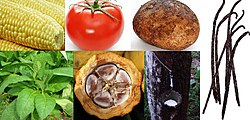Usev — разлика између измена
. |
(нема разлике)
|
Верзија на датум 20. јул 2019. у 21:18

Usev je biljni ili životinjski produkt that can be grown and harvested extensively for profit or subsistence.[1] Crop may refer either to the harvested parts or to the harvest in a more refined state. Most crops are cultivated in agriculture or aquaculture. A crop is usually expanded to include macroscopic fungus (e.g. mushrooms), or alga (algaculture).
Most crops are harvested as food for humans or fodder for livestock. Some crops are gathered from the wild (including intensive gathering, e.g. ginseng).
Important non-food crops include horticulture, floriculture and industrial crops. Horticulture crops include plants used for other crops (e.g. fruit trees). Floriculture crops include bedding plants, houseplants, flowering garden and pot plants, cut cultivated greens, and cut flowers. Industrial crops are produced for clothing (fiber crops), biofuel (energy crops, algae fuel), or medicine (medicinal plants).
Važni prehrambeni usevi

The importance of a crop varies greatly by region. Globally, the following crops contribute most to human food supply (values of kcal/person/day for 2013 given in parentheses): rice (541 kcal), wheat (527 kcal), sugarcane and other sugar crops (200 kcal), maize (corn) (147 kcal), soybean oil (82 kcal), other vegetables (74 kcal), potatoes (64 kcal), palm oil (52 kcal), cassava (37 kcal), legume pulses (37 kcal), sunflowerseed oil (35 kcal), rape and mustard oil (34 kcal), other fruits, (31 kcal), sorghum (28 kcal), millet (27 kcal), groundnuts (25 kcal), beans (23 kcal), sweet potatoes (22 kcal), bananas (21 kcal), various nuts (16 kcal), soybeans (14 kcal), cottonseed oil (13 kcal), groundnut oil (13 kcal), yams (13 kcal).[2] Note that many of the globally apparently minor crops are regionally very important. For example in Africa, roots & tubers dominate with 421 kcal/person/day, and sorghum and millet contribute 135 kcal and 90 kcal, respectively.[2]
In terms of produced weight, the following crops are the most important ones (global production in thousand metric tonnes):[3]
| Usev | 2000 | 2013 |
|---|---|---|
| Sugarcane | 1,256,380 | 1,877,110 |
| Maize | 592,479 | 1,016,740 |
| Rice | 599,355 | 745,710 |
| Wheat | 585,691 | 713,183 |
| Potato | 327,600 | 368,096 |
Vidi još
- Opšte teme i ekonomija
- Floriculture crops
- Management practices
- Cover crop
- Crop destruction
- Crop residue
- Crop rotation
- Crop weed
- Kharif crops (crops specific to South Asia)
- Nurse crop
- Rabi crops (crops specific to South Asia)
- Genetic diversity
- Origin
- guerrilla gardening
Reference
- ^ „Definition of CROP”. www.merriam-webster.com. Приступљено 20. 6. 2017.
- ^ а б „FAOstats Food Supply - Crops Primary Equivalent”. Food and Agriculture Organization of the United Nations, Statistics Division. 2017.
- ^ FAO 2015. FAO Statistical Pocketbook 2015, ISBN 978-92-5-108802-9, p. 28
Literatura
- Sleper, David A.; Poehlman, John M. (2006). Breeding Field Crops. Blackwell Publishing. ISBN 9780813824284. Приступљено 5. 12. 2011.
- Acquaah, George (2002). Principles of Crop Production: Theory, Techniques, and Technology. Prentice Hall. ISBN 978-0-13-022133-9.
- Chrispeels, Maarten J.; Sadava, David E. (1994). Plants, Genes, and Agriculture. Boston, Massachusetts: Jones and Bartlett. ISBN 978-0-86720-871-9.
- Needham, Joseph (1986). Science and Civilization in China. Taipei: Caves Books.
- Safety and health in agriculture. International Labour Organization. 1999. ISBN 978-92-2-111517-5. Архивирано из оригинала 22. 7. 2011. г. Приступљено 13. 9. 2010.
- Larson, G.; Piperno, D. R.; Allaby, R. G.; Purugganan, M. D.; Andersson, L.; Arroyo-Kalin, M.; Barton, L.; Climer Vigueira, C.; Denham, T.; Dobney, K.; Doust, A. N.; Gepts, P.; Gilbert, M. T. P.; Gremillion, K. J.; Lucas, L.; Lukens, L.; Marshall, F. B.; Olsen, K. M.; Pires, J.C.; Richerson, P. J.; Rubio De Casas, R.; Sanjur, O.I.; Thomas, M. G.; Fuller, D.Q. (2014). „Current perspectives and the future of domestication studies”. PNAS. 111 (17): 6139—6146. Bibcode:2014PNAS..111.6139L. PMC 4035915
 . PMID 24757054. doi:10.1073/pnas.1323964111
. PMID 24757054. doi:10.1073/pnas.1323964111  .
. - Ensminger, M. E.; Parker, R. O. (1986). Sheep and Goat Science (Fifth изд.). Interstate Printers and Publishers. ISBN 978-0-8134-2464-4.
- Broudy, Eric (1979). The Book of Looms: A History of the Handloom from Ancient Times to the Present. UPNE. ISBN 978-0-87451-649-4. Архивирано из оригинала 10. 2. 2018. г.
- Gerritsen, R. (2008). „Australia and the Origins of Agriculture”. Encyclopedia of Global Archaeology. Archaeopress. ISBN 978-1-4073-0354-3. doi:10.1007/978-1-4419-0465-2_1896.
- Janick, Jules. „Ancient Egyptian Agriculture and the Origins of Horticulture” (PDF). Acta Hort. 583.
- Kees, Herman (1961). Ancient Egypt: A Cultural Topography. University of Chicago Press.
- Glick, Thomas F. (2005). Medieval Science, Technology And Medicine: An Encyclopedia. Volume 11 of The Routledge Encyclopedias of the Middle Ages Series. Psychology Press. стр. 270. ISBN 978-0-415-96930-7.
